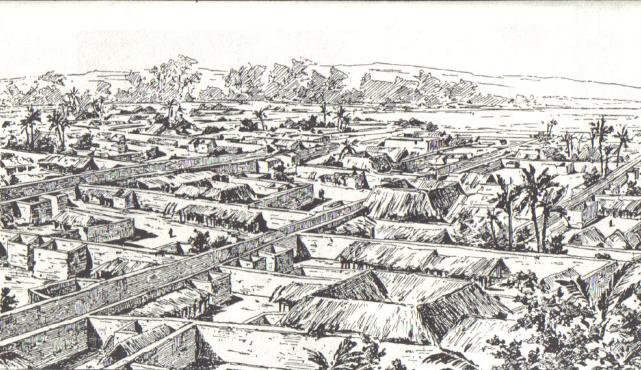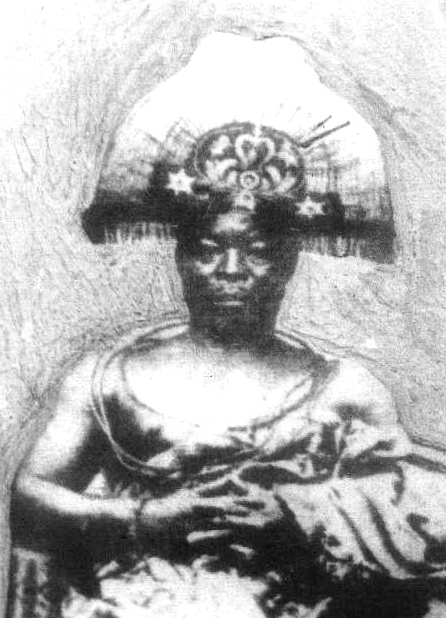|
Aruanran
Aruan of Udo refers to a Benin mythical prince in the ancient city of Benin, born to Oba Ozolua by Queen Ohonmi. History According to Benin's oral history, Aruan was a giant who could sweep the city of Benin using palm trees. Sometimes spelled as Arhuanran or Aruanran, Aruan was destined to be an Oba of Benin Kingdom, but the circumstances surrounding his birth meant he lost the throne to his younger brother who was born the same day. Benin Oral history says that Prince Idubor, who later became Aruan, was born in the morning but didn't cry at birth. His brother Prince Osawe, on the other hand, who later became Oba Esigie, was born in the afternoon by Queen Idia and cried first. As compensation for missing out on becoming Oba of Benin, his father, Oba Ozolua, made him the Duke of Udo, a town not far from Benin City. See also * Edo People * Kingdom of Benin The Kingdom of Benin, also known as Great Benin, is a traditional kingdom in southern Nigeria. It has no historical ... [...More Info...] [...Related Items...] OR: [Wikipedia] [Google] [Baidu] |
Idia
Idia was the mother of Esigie, who reigned as Oba (king) of the Edo people from 1504 to 1550. Life Historians are uncertain as regards her period of life; they do know that Idia was alive during the Idah war (1515 – 1516) because she played a role that led to a great Benin victory. It has been argued that Idia, therefore, was the true power behind the throne of her son. She played a significant role in the rise and reign of the king, being described as a great warrior who fought relentlessly before and during her son's reign as the Oba (king) of the Edo people. Queen Idia was instrumental in securing the title of Oba for her son Esigie following the death of his father Oba Ozolua. To that end, she raised an army to fight off his brother Arhuaran, who was supposed to be the Oba by right and tradition but who was subsequently defeated in battle. Esigie’s mother became the 1st Iyoba of Benin. Idia first entered the royal household because Ozolua, the Oba from 1483 un ... [...More Info...] [...Related Items...] OR: [Wikipedia] [Google] [Baidu] |
Benin City
Benin City serves as the Capital city, capital and largest Metropolitan area, metropolitan centre of Edo State, situated in Nigeria, southern Nigeria. It ranks as the List of Nigerian cities by population, fourth-most populous city in Nigeria, according to the Census in Nigeria, 2006 national census, preceded by Lagos, Kano (city), Kano, and Ibadan. Geography Benin City is located in close proximity to the Benin River, situated approximately to the north, whilst its eastern perimeter lies from Lagos via the arterial road network. The city's municipal boundaries converge with those of several prominent neighbouring towns in Nigeria, southern Nigeria, notably Agbor, Oghara, and Ekpoma. Agriculture Benin City boasts an exceptionally fertile agricultural landscape and serves as the epicentre of Nigeria's thriving Natural rubber, rubber industry. Additionally, the production of palm oil constitutes a substantial sector, further underscoring the city's prominence in Nigeria ... [...More Info...] [...Related Items...] OR: [Wikipedia] [Google] [Baidu] |
Oba Ozolua
Ozolua, originally known as Prince Okpame, was the fifteenth Oba of the Kingdom of Benin who reigned from . He greatly expanded the Kingdom through warfare and increased contact with the Portuguese Empire, and was later called , meaning Ozolua the Conqueror in Edo. He was an important Oba in the history of the Kingdom of Benin and retains importance in the folklore and celebrations of the region. History Prince Okpame was the third and the youngest son of Ewuare who had significantly expanded the Kingdom of Benin during his reign from 1440 until 1473. Following the death of Ewuare, his eldest surviving son, Esi, was assassinated by a poison arrow at his coronation and his second oldest son, Olua, ruled with significant domestic dissent for seven years. After a short-lived rule of the kingdom by a collection of chieftains, Prince Okpame was named the ''Oba'' in 1483 after a three-year interregnum and took the name ''Ozolua''. His rule was defined largely by significant militar ... [...More Info...] [...Related Items...] OR: [Wikipedia] [Google] [Baidu] |
Oba Of Benin
The Oba of Benin is the traditional ruler and the custodian of the culture of the Edo people and all Edoid people. The then Kingdom of Benin (not to be confused with the modern-day and unrelated Republic of Benin, which was then known as Dahomey) has continued to be mostly populated by the Edo (also known as Benin ethnic group). The dynasty is sometimes called the "Eweka dynasty", after its first ruler, Eweka I, and was preceded by the Ogiso monarchy. In 1897, a British military force of approximately 1,200 men under the command of Sir Harry Rawson mounted the Benin punitive Expedition. The force was dispatched in retaliation to the ambush of a British party, at Ugbine village near Gwato on 4 January 1897 by a group of Benin soldiers who were acting without orders from the Oba; the ambush had led to the deaths of all but two of the British party. The British force captured the capital of the Kingdom of Benin, sacking and burning the city while forcing the Oba of Benin, Ov ... [...More Info...] [...Related Items...] OR: [Wikipedia] [Google] [Baidu] |
Esigie
Esigie (also spelt Oseigie), originally known as Osawe, was the son of Oba Ozolua, who reigned in the late 15th century, and his second wife, Queen Idia. He was the sixteenth Oba who ruled the medieval Benin Kingdom, now Benin City, Edo State, Nigeria from . Works of art commissioned by Esigie are held in prominent museums including the Metropolitan Museum of Art and the British Museum. After Ozolua's death, Esigie controlled Benin City, while his brother Arhuaran controlled Udo, a town about northwest of Benin City, that was nearly its equal in size and influence. Following a bitter power struggle with Arhuaran, and with major assistance and support from his mother Idia, Esigie gathered the Benin army at Unuame on the river Osse and from there launched an attack and overthrew Arhuanran. Esigie became Oba of Benin and would later fend off an attack from the Igala people. Esigie started a tradition in Benin by abolishment of the killing of the king's mother, giving Idia the ... [...More Info...] [...Related Items...] OR: [Wikipedia] [Google] [Baidu] |
Edo People
The Edo people, also referred to as the Benin City, Benin people, are an Edoid languages, Edoid-speaking Ethnicity, ethnic group. They are prominently native to seven Edo South Senatorial District, southern Local government areas of Nigeria, local government areas of Edo State, Nigeria. They are speakers of the Edo language and are the descendants of the founders of the Benin Empire, Benin Kingdom, Ogiso Igodo. They are closely related to other Edoid languages, Edoid ethnic groups, such as the Esan people, Esan, the Etsakọ people, Etsakọ, the Isoko language, Isoko and Owan, Urhobo as well as other southern ethnic groups. The names ''Benin City, Benin'' and ''Bini'' are Portuguese people, Portuguese corruptions, ultimately from the word ''Ubini'', which came into use during the reign of Oba of Benin, Oba (ruler) Ewuare, c. 1440. ''Ubini'' is an Edo State, Edo word meaning 'livable', used by Pa Idu, the progenitor of the Edo state people, to describe the area found as a livable ... [...More Info...] [...Related Items...] OR: [Wikipedia] [Google] [Baidu] |
Kingdom Of Benin
The Kingdom of Benin, also known as Great Benin, is a traditional kingdom in southern Nigeria. It has no historical relation to the modern republic of Benin, which was known as Dahomey from the 17th century until 1975. The Kingdom of Benin's capital was Edo, now known as Benin City in Edo State, Nigeria. The Benin Kingdom was one of the oldest and most developed State (polity), states in the coastal hinterland of West Africa. It grew out of the previous Edo people, Edo Kingdom of Igodomigodo around the 11th century AD; it was annexed by the British Empire in 1897, but endured as a non-sovereign monarchy. In the 15th and 16th centuries, the kingdom reached the height of its prosperity, expanding its territory, trading with European powers, and creating a remarkable artistic legacy in cast bronze, iron, brass, carved ivory, and other materials. History Early By the 1st century BC, the Benin territory was partially agricultural; and it became primarily agricultural by around A. ... [...More Info...] [...Related Items...] OR: [Wikipedia] [Google] [Baidu] |



